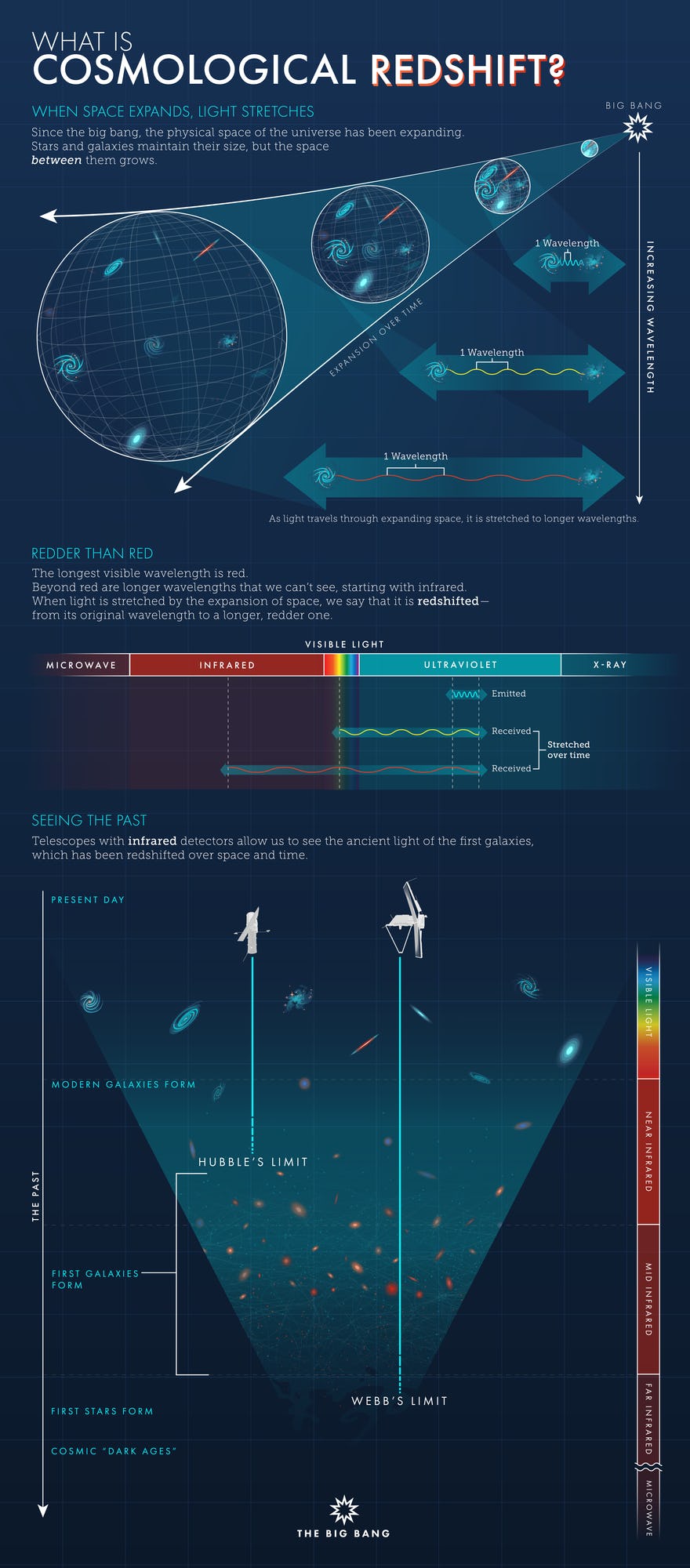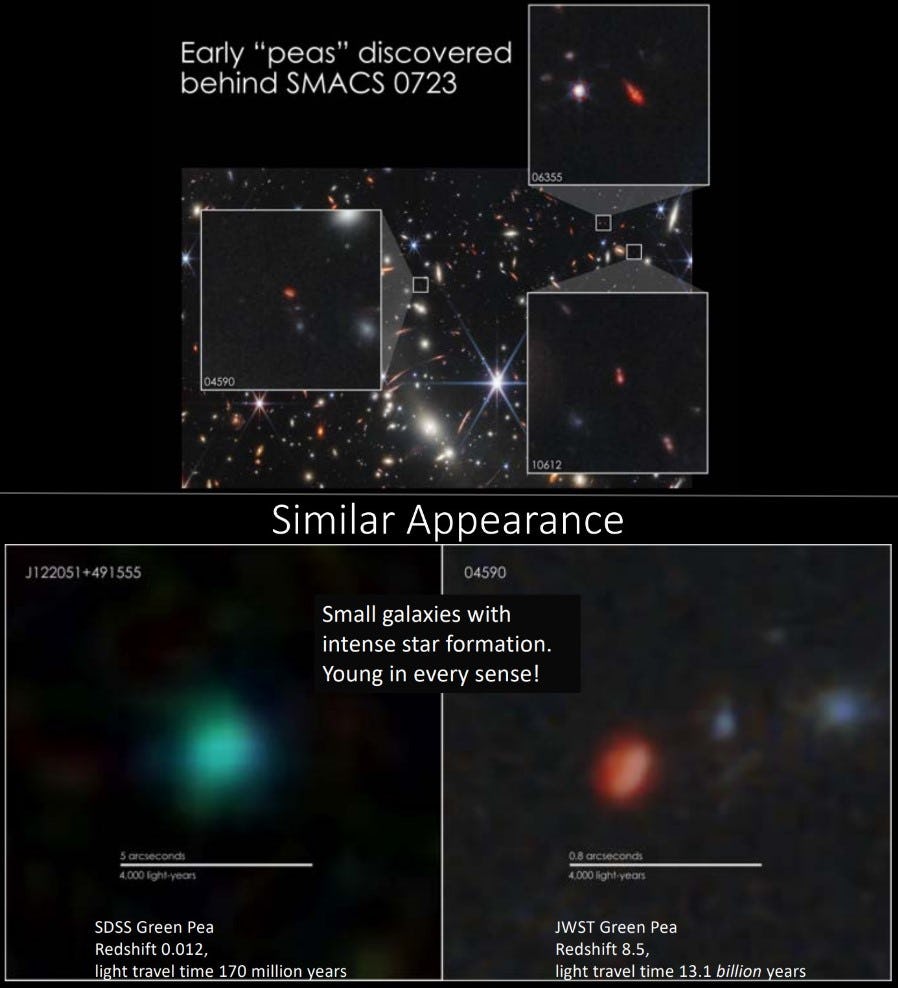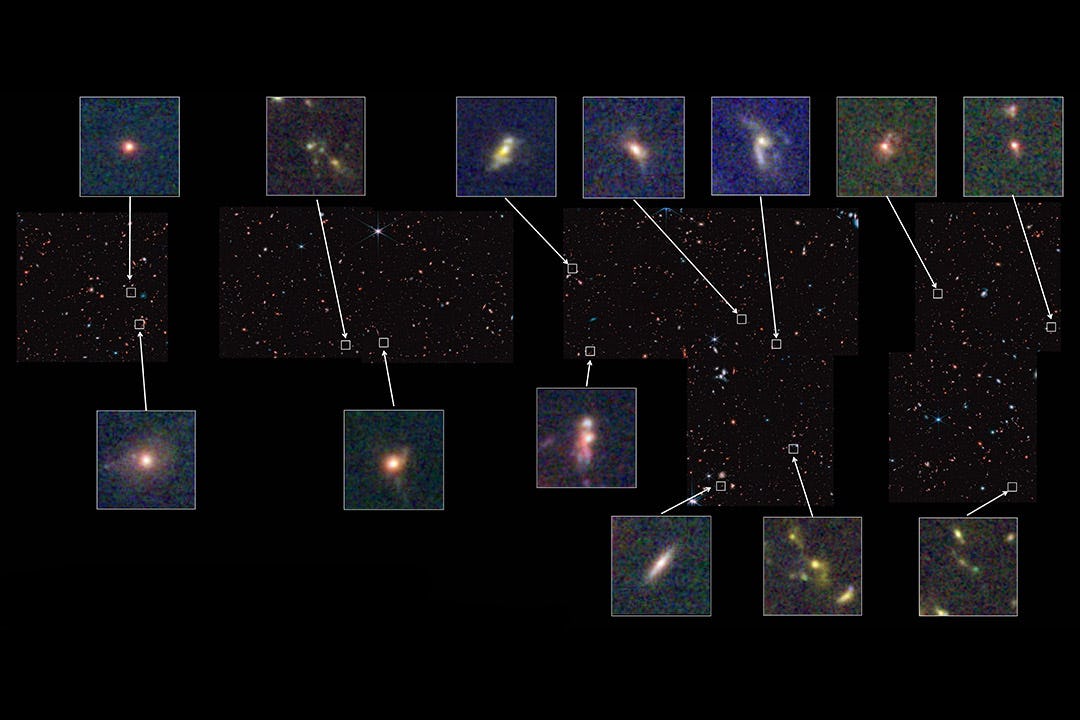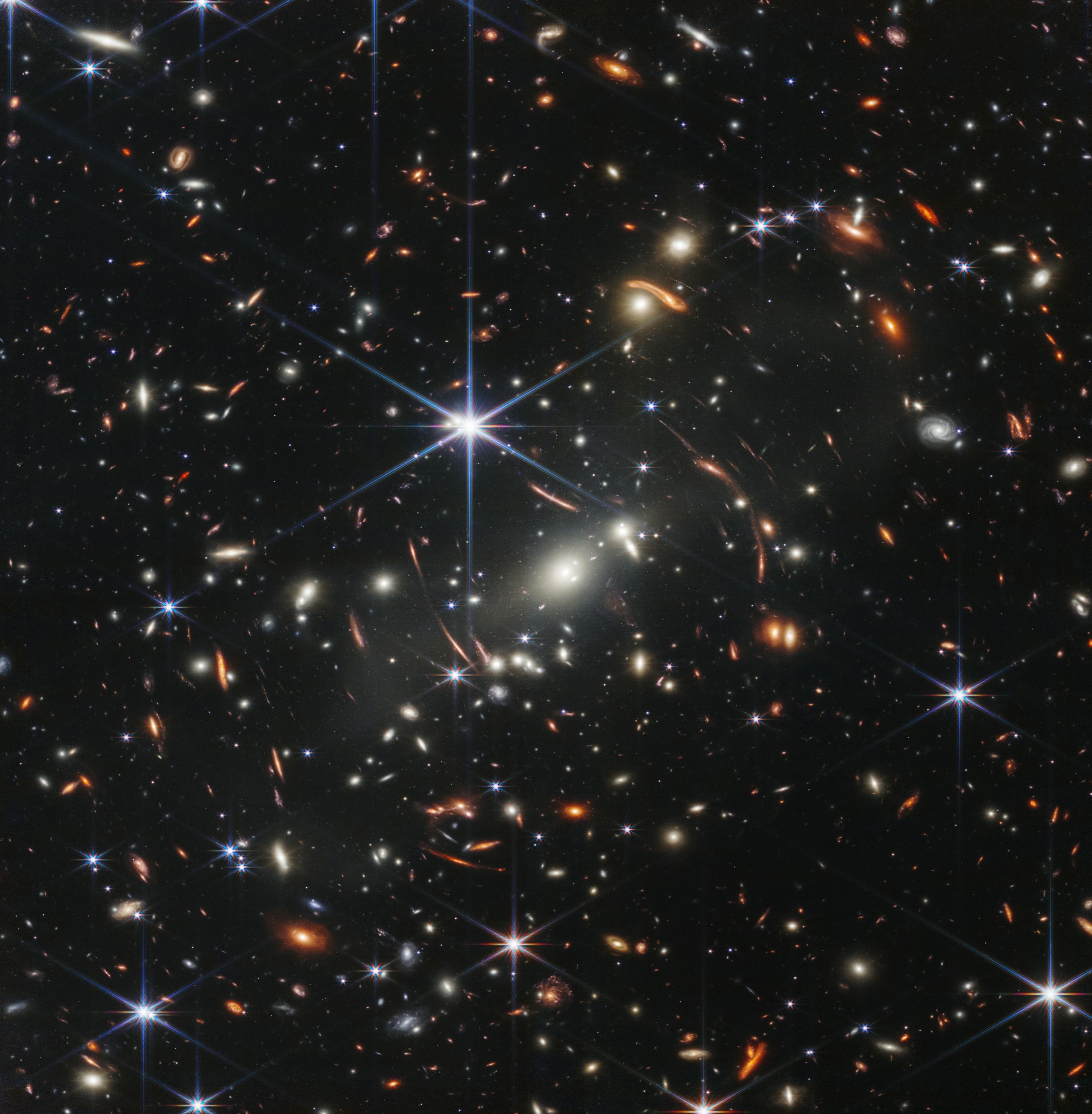
At some point, the first stars formed. Then came small galaxies. Like a celestial Macondo, each galaxy became a hometown for stellar family trees. When these ancestors receded away in an expanding Universe, their light stretched into obscurity, and only now have astronomers begun to see them. The early galaxies also germinated gasses whose glow we’re only now detecting, visible thanks to the same science that governs the fluorescent lights in the window of your favorite bodega.
Once several generations of stars grew and died within these galaxies, which kept a rich inheritance of stellar fusion byproducts from slipping away into the void of space, the Universe had enough heavy elements to make life on Earth, and the world we know.
What happened in the beginning to bring us to what we see today? With the James Webb Space Telescope (JWST), astronomers can investigate “Cosmic Dawn” like never before. The observatory has been online for less than a year, but in that time, the quest to understand our cosmic genealogy has taken unexpected turns.
It’s seen more early galaxy candidates than predicted, showcased their shapes, and might place galactic evolution at an earlier timescale. JWST has also validated astronomers’ best first guesses about earmarked phenomena that are, in theory, rooted in the early Universe, but which have not been thoroughly explained before.
A cosmic ‘Rosetta Stone’
Cosmic Dawn is a time period within the first billion years of the Universe’s 13.8 billion-year existence when astronomers think the first stars, galaxies, and black holes formed.

Since JWST can discern where more stars are huddled inside early galaxies, astronomers gain a sharper image of their shapes. By contrast, the same ancient galaxies studied via its predecessor, the Hubble Space Telescope, looked less defined. Both telescopes can see infrared wavelengths in the electromagnetic spectrum.
For distant objects, infrared astronomy is like a Rosetta Stone.
Astronomers work backward; they translate Hubble’s observations into what was once ultraviolet light, deduce that exceptionally-bright stars emitted that radiation, and resolve a simple contour for the galaxy shape. They convert one into another because they know the Universe has stretched ultraviolet light into a band of infrared over billions of years of cosmic expansion.
But more average stars were invisible to Hubble. “That means that in the distant universe, we really only saw the tip of the iceberg,” Dan Coe, a JWST instrument scientist at the Space Telescope Science Institute in Maryland, tells Inverse.
Let there be light (and gas)
“With Hubble, you were really only able to see like the hot, massive, bright stars that glow really bright in ultraviolet,” Coe says. “Now with JWST, you see the stars like our Sun, you're able to get that full census of what all the stars are, as you're not just seeing the hot young ones that burn out fast and die young. Now you're seeing all the rest of the stars of the galaxy, so that means that you can see, like a spiral disc, [which] you wouldn't have seen before.”
And there are many thrilling shapes appearing from the far end of our bloated Universe.
“It's like interviewing three people to get a sense of what's going on in a city, right? You'll get some idea. They'll tell you about their own lives, their experiences, they won't be lying. But it's not the same as taking a survey of 100 people, or 1,000 people.” — James Rhoads
A team led by Jeyhan Kartaltepe, astrophysics professor and director for the Laboratory for Multiwavelength Astrophysics (LAMA) at the Rochester Institute of Technology in New York, used JWST and Hubble data to analyze 850 early galaxies from 11-13 billion years ago. They found that the young Universe contained galaxies with a wide mix of shapes, including disks, suggesting that galactic evolution started earlier than what JWST can see, and sooner than once thought.
“Some of the earliest galaxies we're seeing that are already established are a few hundred million years after the Big Bang … which sounds like a long time but astronomically speaking, it is pretty quick,” Kartaltepe tells Inverse. But she adds, “that very early timeline is still fairly uncertain.”
And although unexpected, Coe tells Inverse that scientists are thrilled that their best guesses and computer simulations are turning out to be accurate, even with the weird new formation timelines.
Not only can the telescope tell the galaxies’ surprising shapes, it also captures the glow of its gasses. Like a fluorescent lamp, gasses from distant galaxies emit light. Through a technique called spectroscopy, astronomers dissect the light to uncover what elements are present. And JWST spectroscopy might advance the frontiers of astronomy to exciting new places. Take for instance, “green pea” galaxies.

At the 241st Meeting of the American Astronomical Society in Seattle in January, extragalactic astrophysicist James Rhoads from NASA’s Goddard Space Flight Center in Maryland spoke about JWST spectroscopy of early galaxies and how the data looks oddly similar to a class of closeby galaxies he studies, called “green peas.” These round blobs of gas are rare, located in the nearby Universe, and funny enough, have spectroscopic profiles surprisingly similar to three ancient galaxies “observed when the universe itself was ≲700 Myr [million years] old, or about 5 percent of its current age,” according to the recent paper describing the findings.
“We've scratched the surface with these first three,” Rhoads tells Inverse. He follows with an analogy to express why it's important to point telescopes like JWST at even more ancient galaxies.
“It's like interviewing three people to get a sense of what's going on in a city, right? You'll get some idea. They'll tell you about their own lives, their experiences, they won't be lying,” he says. “But it's not the same as taking a survey of 100 people, or 1,000 people, and understanding the statistics of, you know, what is life like in that city, or in this case, what are conditions like in the early Universe. So I'm excited to see more of that.”
A new and essential tool
JWST harbors four highly-sensitive instruments in a frigid environment a million miles from Earth. Coupled with its large size, the telescope provides a new way for researchers like Marcia Rieke to answer questions they couldn’t resolve before about our origins.
Rieke is a professor of astronomy at the University of Arizona, and is the principal investigator for JWST’s Near-Infrared Camera (NIRCam). When she was a graduate student in the 1970s, she became fascinated with infrared astronomy, a then-new approach to studying the cosmos.
The Universe has been expanding since the superheated frenzy of the Big Bang. Early galaxies lived in a smaller Universe than today, and as space expanded, their light stretched extremely. Light is a reliable metric for vast distances and time, and that’s because it has a finite speed despite how instantaneous it often feels to us.
Altogether, this means that astronomers can peer back in time the farther they look, and that the older light will have shifted more than younger light. What was once visible light billions of years ago has now stretched into infrared wavelengths of light in the electromagnetic spectrum just beyond the color red. Rieke and others hoped infrared observatories, of which JWST is the latest, could reveal objects and structures now otherwise invisible.

The search for the first galaxies
Thanks to early 20th-century astronomers Henrietta Swan Leavitt and Edwin Hubble, we learned that some stars could help measure distances in space, and that there existed galaxies outside and far away from our own. What’s more, galaxies are moving away from us.
And if they had a receding motion, maybe there was more to see out there: ancient galaxies might be hiding in plain sight, masked by the stretch of their light, called redshift.
Decades later, Rieke and others had renewed hope when the cutting-edge Wide Field and Planetary Camera 2 onboard the Hubble Space Telescope captured the iconic Hubble Deep Field image in 1996. As deputy principal investigator of the Multi-Object Spectrometer for the Hubble Space Telescope (NICMOS), Rieke was elated.
There they were. And rather than parse through a section of sky one pixel at a time, space telescopes could snap a view like a digital camera. Things weren’t as “tedious” as they were before.
JWST furthermore expedites cosmic exploration by rendering a deep field in much less exposure time than its predecessors. The Hubble Deep Field was revolutionary, but achieving it required 10 consecutive days of exposure between December 18 and 28, 1995 when the camera took more than 300 images, one after the other. In a fraction of that time — only 12.5 hours of exposure — NIRCam unpacked a patch of sky smaller than a grain of sand held at arm’s length, and uncovered a sea of galactic spirals, disks, and slugs. Some could never have been seen without this telescope. This was Webb’s 2022 First Deep Field.

The new telescope can also see farther back in time. With JWST, Rieke and a team spotted candidates for the farthest, and therefore oldest, galaxies ever seen. They were “relieved,” Rieke tells Inverse, “to see that our observing plan was yielding the results that we hoped for.”
In the beginning
Following the Big Bang 13.8 billion years ago, everything looked much different than it does today. Hydrogen made up most of the stuff in space, with some helium sprinkled in. But there was a lot of it.
Coupled with a much smaller Universe, and this was the right foundation for stars, the life-sustaining heirlooms like oxygen and carbon they’d eventually expel, and the first galaxies they’d call home.
“Basically, everything about the very early Universe is driven by gravity,” Kartaltepe says.
Over time, gravity caused the material to get closer and closer together. The strength of gravity caused the stuff to collapse, and certain pockets got denser and hotter “until the first stars were able to form,” she says. They then aggregated into protogalaxies. From here, they grew bigger and became more massive.
It’s fascinating to wonder what the first version of stellar and galactic activity was like. The Universe has less gas free-floating in space to make stars now, and galaxies have largely taken shape. Present and future stars and galaxies will be made from recycled dust and gas and the by-products of older stars and galaxies. The Milky Way may have been made of smaller galaxies, duking it out today with the Small and Large Magellanic Clouds, and one day will collide with the nearby Andromeda galaxy to continue the process.
But back then, there was only raw material, like a house with only a purchase order and no blueprint.







